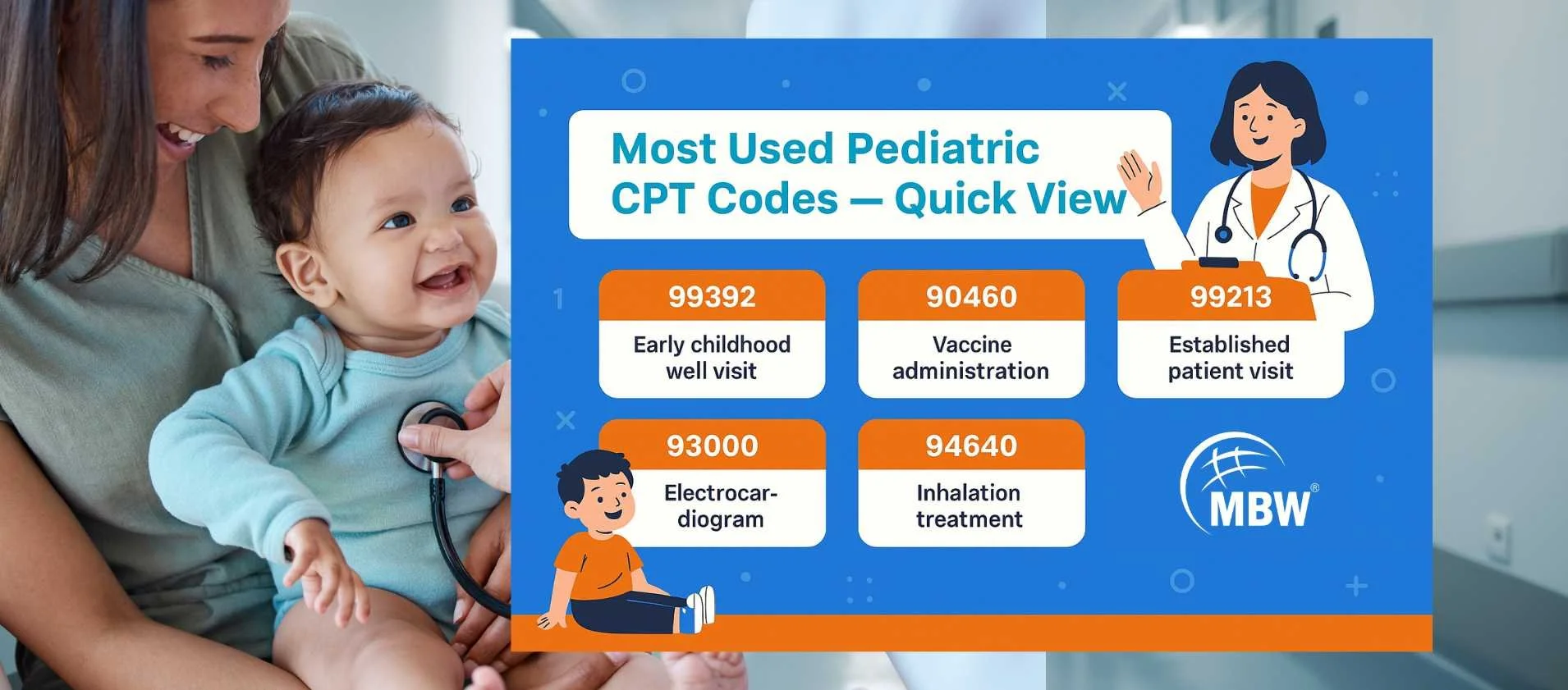Pediatric Billing Cheat Sheet: For Beginners and Busy Practices
A Pediatric Billing Cheat Sheet is one of the fastest ways to bill correctly and save time in a busy pediatric clinic. This guide brings together the most commonly used CPT, ICD-10 codes, and modifiers—plus real billing examples like vaccines, sick visits, telehealth, and newborn care. Whether you're new to billing, handling high patient volume or need a quick reference during packed schedules, this cheat sheet is designed to help you avoid denials and submit cleaner claims—faster.
Getting Started with Pediatric Billing Cheat Sheet
A Pediatric Billing Cheat Sheet is a quick reference tool that helps you apply the correct codes for pediatric visits, vaccines, and procedures. It’s designed for front-desk teams, new billers, and small clinics needing fast, accurate billing without hours of training. It organizes codes and tips so you don’t miss revenue or submit incorrect claims.
Evaluation & Management Codes in Pediatric Billing Cheat Sheet
Evaluation and Management (E/M) codes are used for most pediatric office visits. These CPT codes depend on time spent, complexity, and patient history. Codes like 99213 (15-minute visit) or 99214 (more complex case) appear frequently in the Pediatric Billing Cheat Sheet. Always match the visit type with the correct level of service.
Most Used Pediatric CPT Codes (Well-Child & Sick Visits)
CPT codes are the core of pediatric billing. Well-child checkups and sick visits require different codes, depending on age and visit type. The Pediatric Billing Cheat Sheet simplifies this by listing the most-used codes and when to apply them.
Well-Child Visits (Preventive Care):
99381–99385: New patient preventive care (ages 0–17)
99391–99395: Established patient preventive care (ages 0–17)
Sick Visits (Problem-Oriented Care):
99212: Short, low-complexity visit
99213: Mid-level visit with limited complexity
99214: Moderate-level decision-making and documentation
| CPT Code | Description |
|---|---|
| 99391 | Well-child visit (under 1 year) |
| 99392 | Well-child (1–4 years) |
| 99393 | Well-child (5–11 years) |
| 99212 | Office visit, straightforward decision-making |
| 99213 | Office visit, low complexity |
| 99214 | Office visit, moderate complexity |
| 99460 | Newborn hospital care (initial day) |
| 99462 | Newborn discharge day |
| 99463 | Newborn same-day admit and discharge |
| 90460 | Vaccine admin with counseling (first component) |
These codes must match both the documentation and the patient's age. Preventive and problem-oriented visits should not be confused.
“CPT codes may look like numbers, but they tell the story of every patient visit.”
ICD-10 Codes Pediatric Billing Cheat Sheet Should Include
ICD-10 codes explain why a service was performed and must align with the CPT code used. In pediatric billing, selecting the correct diagnosis code ensures claim approval and prevents denials. The Pediatric Billing Cheat Sheet helps you connect the right diagnosis with the procedure for common pediatric encounters.
Here are frequently used ICD-10 codes in pediatric settings:
| ICD-10 Code | Description |
|---|---|
| Z00.129 | Routine child health examination |
| Z23 | Encounter for immunization |
| J06.9 | Acute upper respiratory infection |
| R50.9 | Fever, unspecified |
| H66.9 | Otitis media (ear infection), unspecified |
| B34.9 | Viral infection, unspecified |
| R05 | Cough |
| Z76.89 | Persons encountering health services for other reasons |
These codes are commonly used for well-child checks, vaccinations, cold/flu symptoms, and general sick visits. Always check payer policies and link the ICD-10 code to the most accurate presenting complaint or visit purpose.
If you're curious to know more about specialty coding, take a look at this blog: Orthopedic Surgery Coding Cheatsheet.
Modifiers in Pediatric Billing Cheat Sheet
Modifiers are two-digit codes added to CPT codes to explain special circumstances or exceptions during a patient visit. In pediatric billing, they help describe services that differ from what is typically expected and prevent claim denials due to conflicting or overlapping codes.
Common Pediatric Modifiers:
| Modifier | Meaning | When to Use |
|---|---|---|
| 25 | Extra E/M service | Sick visit during well-child visit |
| 59 | Separate procedure | Two unrelated procedures, same day |
| 26 | Provider’s part only | Imaging, report only |
| 51 | Multiple procedures | Two+ procedures in one session |
| 95 | Telehealth service | Video/audio visit billing |
Use modifiers carefully and only when documentation supports their necessity. Incorrect use may lead to audits or claim denials. The Pediatric Billing Cheat Sheet includes real-life examples so you know when and how to apply them.
“Modifiers are small details with a big impact—use them wisely, bill them correctly.”
Common Pediatric Billing Cases and How to Code Them
Everyday clinic visits require more than general codes. Here are common real-world billing cases that the Pediatric Billing Cheat Sheet covers:
Billing Pediatric Vaccines with the Right Product and Admin Codes
To bill vaccines correctly, you need both the product code (e.g., 90700 for DTaP) and the administration code (e.g., 90460 if counseling is given). Always document which vaccines were given and whether parental counseling took place.
Using Time-Based Codes for Longer or Counseling Visits
Use codes like 99417 (add-on for prolonged services) when a visit exceeds the typical time. If counseling dominates the visit, time-based coding can apply. Billers should record the exact time spent and use this section of the Pediatric Billing Cheat Sheet often.
Submitting Telehealth Claims for Pediatric Appointments
Telehealth billing requires modifier 95 and place-of-service code 02. Use standard E/M codes (like 99213) and apply modifiers. During the pandemic, these became common, and many payers still accept them under updated rules.
Coding Newborn Hospital Visits with the Correct CPT Codes
Use 99460 for initial newborn hospital care, 99462 for discharge day, and 99463 if the newborn is discharged on the same day as admission. These codes are specific and must match documentation.
Pediatric Billing Challenges & Common Claim Denials
Claim denials in pediatric billing are often preventable with proper code selection, documentation, and modifier use. Understanding why claims are denied is essential for improving first-pass approval rates and reducing rework. The Pediatric Billing Cheat Sheet can help staff catch these errors early.
Most Common Reasons for Pediatric Claim Denials:
Inaccurate Code Pairing:
ICD-10 codes must justify the CPT service. For example, pairing a preventive service CPT (like 99391) with a diagnosis code that indicates an acute illness (like J06.9) can cause a mismatch. Always confirm that your diagnosis supports the billed service.
Missing Modifier 25:
If a child is scheduled for a routine exam but also presents with an illness (like an ear infection), you must add Modifier 25 to the E/M code for the sick visit. Without it, the payer may think you’re billing twice for one service.
Incomplete Vaccine Billing:
Administering a vaccine requires two codes: one for the product and another for administration. For example, billing 90700 (DTaP) without 90460 (admin with counseling) will result in partial or full denial. Always confirm both are submitted.
Using Expired Codes:
CPT and ICD-10 codes update yearly. Using outdated codes—even by one digit—can result in automatic rejections. Keep your cheat sheet synced with CMS and payer updates.
Incorrect Patient Demographics:
Something as small as a wrong birthdate, gender, or insurance ID can lead to a rejection. Always double-check this info before claim submission, especially during patient intake.
The Pediatric Billing Cheat Sheet helps you catch these before submission.
Best Practices for Using a Pediatric Billing Cheat Sheet
Using a Pediatric Billing Cheat Sheet effectively means integrating it into your clinic's daily routine and keeping it accurate over time. Here are some best practices that support efficient billing and fewer mistakes:
Keep Multiple Versions Accessible: Maintain both printed and digital copies so staff can reference it from the front desk, back office, or remotely.
Customize Your Cheat Sheet: Highlight or bold the most frequently used codes specific to your practice's services.
Schedule Regular Reviews: At minimum, review and update your cheat sheet every quarter to account for CPT, ICD-10, and payer rule changes.
Train New Staff With It: Use the cheat sheet as a training tool for new hires to speed up onboarding and reduce beginner errors.
Store Near Your EMR or Billing Software: Keep a quick-access tab or folder on desktops where claims are processed.
Medicaid vs Commercial Billing in Pediatric Practices
Understanding the differences between Medicaid and commercial insurance is essential in pediatric billing. Each has its own policies, reimbursement rates, and code requirements. Here's a side-by-side comparison to help you adjust your billing approach:
| Category | Medicaid | Commercial Insurance |
|---|---|---|
| Vaccine Coverage | Often uses VFC program for free vaccines | Reimburses based on policy contracts; billing varies |
| Modifier Usage | May have stricter rules; often needs prior authorization | Generally follows standard CPT guidelines |
| Reimbursement Rates | Typically lower reimbursement rates | Higher, based on insurer contracts |
| Documentation | May require detailed records or proof of necessity | Varies; generally less documentation than Medicaid |
| Billing Requirements | State-specific and varies by program | Depends on individual plan; confirm before submitting |
To avoid rejections, always verify eligibility, payer-specific rules, and coding updates. Adjust your Pediatric Billing Cheat Sheet to reflect these differences.
Quick Reference Tables for Pediatric Billing Cheat Sheet
This table provides a fast lookup for the most frequently used codes in pediatric billing. Whether you're coding for vaccines, office visits, or applying modifiers, these quick references help reduce mistakes and save time during claim entry.
| Category | Code | Use Case Description |
|---|---|---|
| Vaccine | 90700 | DTaP vaccine for routine immunization |
| Admin Code | 90460 | Vaccine admin with counseling (1st dose) |
| Modifier | 25 | Sick visit during a well-child check |
| Modifier | 59 | Separate, unrelated procedure |
| E/M Code | 99213 | Established patient, 15-min office visit |
| E/M Code | 99214 | Established patient, moderate complexity |
| Newborn Care | 99460 | Initial hospital care for newborn |
| Newborn Care | 99463 | Same-day admit and discharge for newborn |
These codes are commonly referenced across most pediatric visits. Keep this section printed or bookmarked near your EMR or billing software for fast access.
Keeping Pediatric Billing Cheat Sheet Updated
To keep your Pediatric Billing Cheat Sheet accurate and effective, review CPT and ICD-10 code updates each January, monitor insurance bulletins, and revise content based on claim trends. Assign someone on your team to handle updates and use EMR tools when possible. Staying current reduces denials and keeps your billing process efficient.
Use the Pediatric Billing Cheat Sheet Every Day!
The Pediatric Billing Cheat Sheet is more than a shortcut—it’s a daily tool for clinics that need to work fast and bill right. With correct CPT, ICD-10, and modifier combinations, you reduce denials and stay efficient.
Save or print this cheat sheet now and keep it easily accessible for quick reference during your daily billing tasks.
For more billing insights, visit our MBW RCM or contact us if you need help, have questions, or want to learn more about our pediatric billing services. Our team is here to support your practice.


